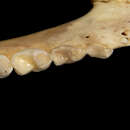Biology
provided by Arkive
Brown lemurs live in multimale-multifemale groups without a noticeable hierarchy, generally numbering from 3 to 12 individuals, with 9 to 12 being the norm (2) (5). Breeding is seasonal with mating usually occurring in May and June. The gestation period is approximately 120 days, with infants born between September and October, at the onset of the rainy season. A single offspring is usual, although twins have been reported (2). Brown lemurs reach sexual maturity between one and three years, and the lifespan in the wild is believed to range between 20 and 25 years (2) (5).
This species is cathemeral, meaning it is active at varying times throughout the day and night. Fruit, mature leaves, flowers, bark, sap, soil, insects, centipedes and millipedes form the bulk of this lemur's diet (6).
Conservation
provided by Arkive
The brown lemur is found in at least 13 protected areas, including four national parks, two strict nature reserves and seven special reserves (3). Captive bred populations also exist in institutions worldwide (5). The fate of the brown lemur in the wild will most probably be determined by the future of its forest habitat, which needs to be better preserved if the survival of this lemur is to be safeguarded.
Description
provided by Arkive
This medium-sized lemur has a horizontal posture, which is suited to its predominantly quadrupedal mode of movement (2). These lemurs are also capable of leaping considerable distances, their long furry tails assisting them in maintaining their balance (5). The short, dense coat of both sexes is grey-brown on the upperparts, and paler and slightly greyer on the underparts. The face, muzzle and crown are dark-grey to black, with faint pale eyebrow patches and paler grey-brown fur around the ears, cheeks and underneath the chin. The eyes are a rich orange-red (2).
Habitat
provided by Arkive
Found in rainforest, moist montane forest and dry deciduous forest (2). Brown lemurs are arboreal and spend most of their time in the upper layers of the canopy (6).
Range
provided by Arkive
This species has a notably disjunct distribution, found in western Madagascar north of the Betsiboka River, on the high plateau in scattered forest fragments, and in eastern Madagascar to the north of the Mangoro River. It has also been introduced to the island of Mayotte in the Comoros (3).
Status
provided by Arkive
Recent scientific thought is that the six subspecies of brown lemur previously acknowledged should be elevated to individual species status, with the nominate subspecies, the common brown lemur (E. f. fulvus), being categorised as the full species, the brown lemur (Eulemur fulvus) (3). As a subspecies, the common brown lemur (E. f. fulvus) is classified as Lower Risk/near threatened (LR/nt) on the IUCN Red List 2004 (1). Listed under Appendix I of CITES (4).
Threats
provided by Arkive
Habitat destruction remains the primary threat to the brown lemur, largely as a result of the explosive growth in the human population on Madagascar (5). Eastern areas of rainforest are destroyed by slash-and-burn agriculture and by forest cutting for fuel wood and construction, while dryer western forests are cleared by fires started to promote new flushes of pasture for grazing cattle. Hunting and trapping for food or the pet trade may also constitute a threat to the brown lemur in some parts of its range (2) (5).

